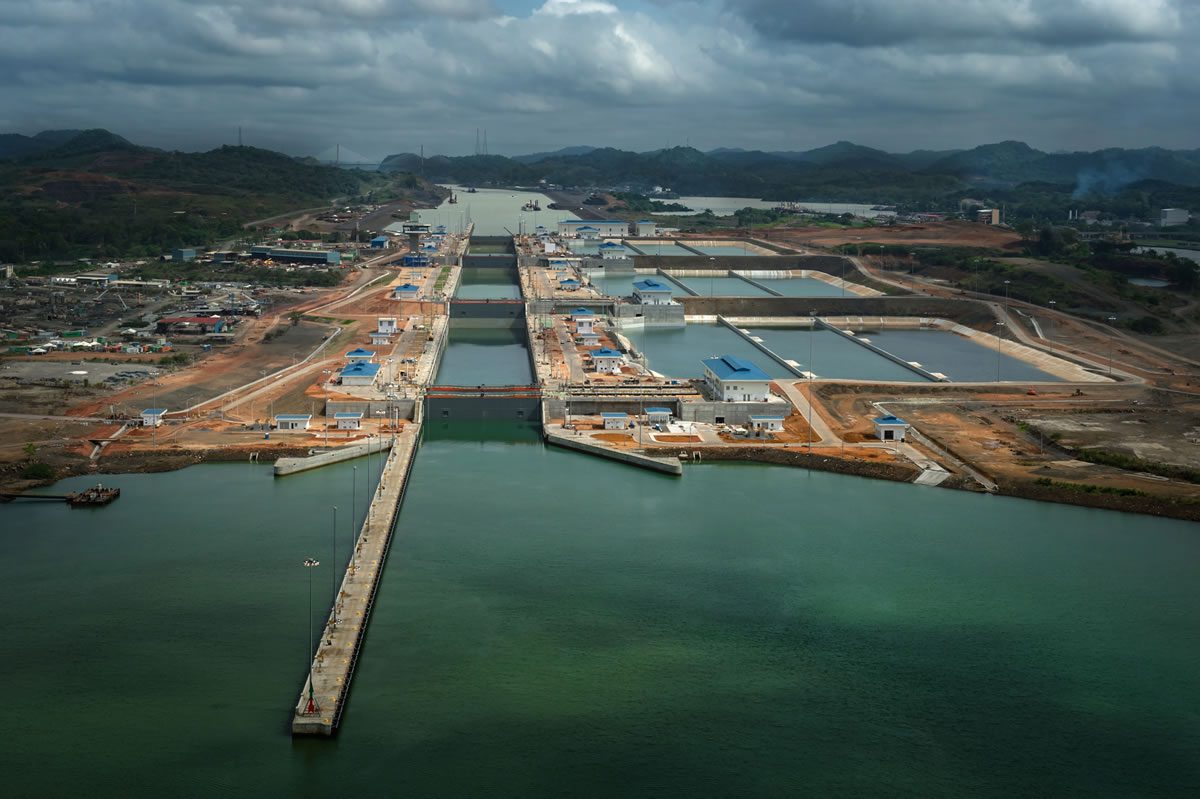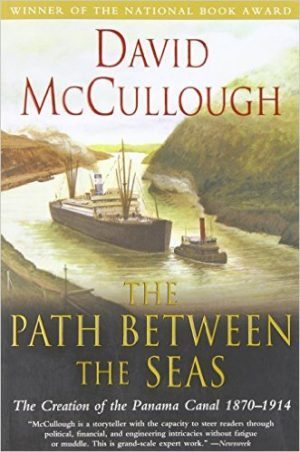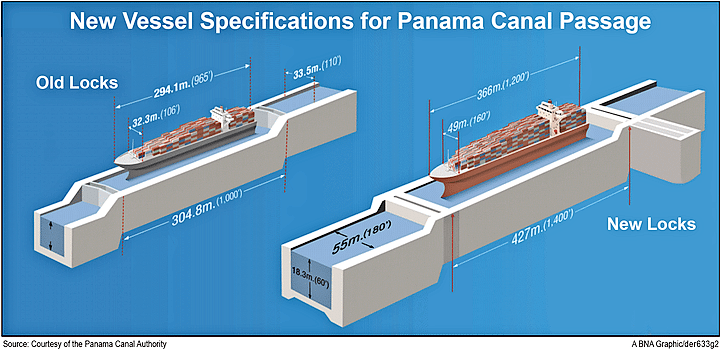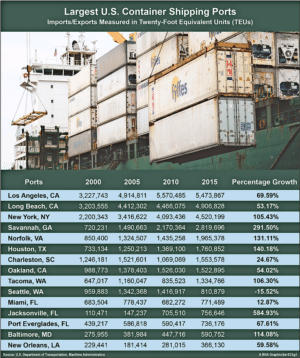Was The World’s ‘Northern-Most Island’ Erased From Charts?
by Kevin Hamilton (University of Hawaii) In 2021, an expedition off the icy northern Greenland coast spotted what appeared to be a previously uncharted island. It was small and gravelly,...


Photo: Panama Canal Authority
By Brandon Ross (BNA) American East Coast port operators aren’t expecting an immediate windfall from the billions of dollars they invested to accommodate bigger container ships transiting the newly enlarged Panama Canal, but they are counting on slow, steady growth over the long haul.


Ports along the Atlantic seaboard have been racing to prepare for this summer’s opening of the expanded Panama Canal by dredging channels and upgrading equipment like massive new cranes to handle larger vessels. They expect these investments will allow them to capitalize on increasing global shipping volume. Analysts also predict the larger canal will allow Eastern Seaboard ports to siphon off some of the market share traditionally handled on the West Coast.
“We were never expecting a massive influx of big ships the second the canal reopened,” Richard Scher, communications director for the Port of Baltimore, told Bloomberg BNA. “We expected it to be a slow, measured process. We are expecting to see consistent growth.”
Already, the expansion has allowed Baltimore to attract new business from Denmark’s AP Moeller – Maersk A/S, which tops the research firm Alphaliner’s list of the world’s largest container shipping companies. The facility also serves Switzerland’s MSC Mediterranean Shipping Company SA, ranked second on Alphaliner’s rankings based on container ship capacity, and No. 5 Evergreen Marine Corp. Ltd. of Taiwan.
“We did not have [Maersk] in the port of Baltimore before last year,” Scher said. “We were able to get Maersk because of our new shipping cranes and infrastructure.”
Baltimore’s experience illustrates the long game that Eastern ports are playing. The deeper and wider canal and the port changes will allow bigger ships primarily from Asia to service the densely populated Atlantic seaboard, rather than loading and unloading at West Coast ports such as Los Angeles and Long Beach, Calif., and then shipping cross-country by rail. And bigger vessels are more cost-effective for shippers than sending the same volume of cargo on multiple smaller vessels.
“You’re going to see the same amount of cargo on fewer ships,” Steve Coleman, deputy director of media relations with the Port Authority of New York and New Jersey, told Bloomberg BNA.
The deeper and wider canal and the $6 billion spent expanding the New York and New Jersey port keeps the facility competitive, Coleman said. The Port Authority expects a continued annual average growth of 4 percent increase in cargo, he said.
Baltimore is also counting on steady single-digit percentage annual growth in the volume of cargo handled.
“Maybe some year it’s 2 [percent growth], and maybe another 5, maybe another 4,” Scher said. “We expect it to grow. Being one of the first ports to be able to accommodate these ships is giving us an opportunity to further cement the relationships that we have with container companies.”




Maritime industry analysts said West Coast ports will probably lose a little of their market share to East Coast competitors with the opening of the larger canal, but they predicted overall growth in shipping will more than offset that shift.
“We are expecting that the opening of the expanded Panama Canal will result in the diversion by 2020 of no more than 5 percent of the containerized imports currently routed through U.S. West Coast ports,” Jock O’Connell, international trade adviser for the consulting firm Beacon Economics told Bloomberg BNA.
The Australian infrastructure and environmental services company Cardno Ltd. also projected a 5 percent shift in market share from West Coast ports to the East and Gulf coasts, Bob West, senior project director in the government services division, told Bloomberg BNA. He said growth at East Coast ports will stem both from taking some market share from the West and “growth in trade itself.” West said a downturn in shipping isn’t “in the scenario for the next five years at least.”
“What the Panama Canal expansion will do is allow the equilibrium cost to ship to the middle parts of the country to move east,” West said. “Now with bigger ships and lower cost, you may be able to ship through the U.S. East Coast and go farther west for the same cost. So what you can see is because of the lower cost, East Coast ports have a larger opportunity to obtain more inland market share.”
Before the Port of Baltimore partnered with Ports America, the largest port terminal operator—called a stevedore—in the U.S., to spend the $105 million on new cranes and dredging to ready for the expansion, the port could handle ships as large as 6,000 twenty-foot equivalent units, or TEUs, Scher said. A TEU is the standard unit used to measure a container ship’s capacity.
“Going from that to the ability to handle 14,000 [TEUs] is really night and day,” Scher said.
The 14,000 TEU size is significant because ships that big are the largest that can fit through the newly expanded canal. There are some ships as large as 18,000 TEU’s, which major West Coast ports can accommodate, but they are not yet widely used. Before its expansion, the Panama Canal could accommodate no ships larger than 5,000 TEUs.
“When you look at the actual ship size that is appropriate from Asia to the East Coast, it is not 18,000 TEU,” West said. “The real workhorse is now 8,000 to 9,000 TEUs.”
Despite the projections, port operators and maritime analysts caution that it’s premature to evaluate the economic impact on U.S. ports of the larger canal. Data for the amount of cargo processed at East Coast ports since the canal’s new locks opened isn’t yet publicly available in most cases.
“The new Panama Canal lock just opened at the end of June,” the Port Authority of New York and New Jersey’s Coleman said. “It’s hard to base projections on a couple of ship calls that have happened so far.”
So far, only four East Coast ports—the Port of Virginia, the Port of Baltimore, one terminal at the Port of New York and New Jersey and Port Miami— stand ready to handle the larger ships, which require navigation channels at least 50-feet deep and expensive new cranes and other accommodations. Dredging at the Port of Savannah, Ga., is scheduled to be completed in 2019 and the port of Charleston, S.C. is expected to begin handling 14,000 TEU vessels later this year. Also, a project to raise the Bayonne Bridge’s roadway to 215 feet above water from 151 feet to give larger ships access to other large terminals at the Port of New York and New Jersey will not be completed until late 2017.
The intermodal network accommodating the trucks and rail cars that carry goods to and from ports will play a vital role in determining how reliable shippers view sending to the East Coast to be for reaching more inland regions of the country, analyst O’Connell said.
Even with a larger Panama Canal and all the improvements, O’Connell said the deepwater West Coast ports will continue to enjoy advantages in trade with Asia.
“The reality is that if you put your box on in Shanghai, it’s going to arrive at L.A.-Long Beach in two weeks,” O’Connell said. On the other hand, shipping to the East Coast involves more guesswork and is always longer, he said, even if it is cheaper than it used to be.
“There’s always congestion along the canal,” he said. “It’s going to take three weeks.”
A U.S. Maritime Administration study of the economic impact of the Panama Canal expansion is available at: http://src.bna.com/hCm.
Copyright © 2016 The Bureau of National Affairs, Inc. All Rights Reserved.
Join the gCaptain Club for curated content, insider opinions, and vibrant community discussions.


Join the 105,932 members that receive our newsletter.
Have a news tip? Let us know.
Access exclusive insights, engage in vibrant discussions, and gain perspectives from our CEO.
Sign Up




Maritime and offshore news trusted by our 105,932 members delivered daily straight to your inbox.



Essential news coupled with the finest maritime content sourced from across the globe.
Sign Up